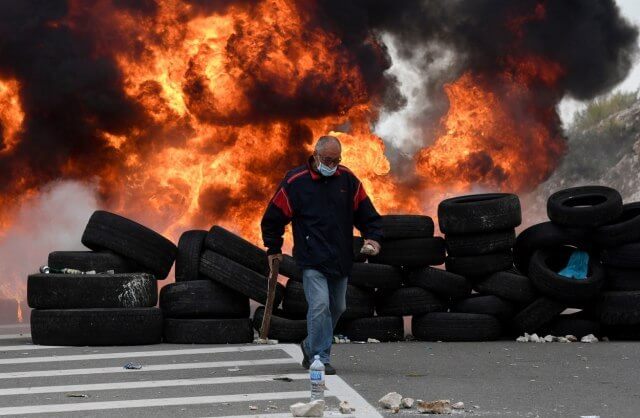Intense protests broke out in Cetinje, Montenegro on Saturday and Sunday against the enthronement of bishop Joanikije as the Metropolitan, or the head, of the Serbian Orthodox Church.
The two-day long protests turned violent as dozens were injured after the police used tear gas on the protesters in retaliation. The ambulance in Cetinje reported 60 injuries on Sunday; 30 members of the Ministry of the Interior were also examined, four of whom were sent to the General Hospital.
On Saturday, thousands of protesters attempted to block the roads leading to Cetinje using tyres, rocks, and vehicles. They also waved their Balkanian nations’ double-headed eagle flag to prevent the enthronement. “They [protesters] don’t plan on leaving...they asked the women to stand as a human wall in front of the barricades of tyres for as long as possible,” Al Jazeera’s Milica Marinovic reported from Cetinje.
Furthermore, protesters ignited massive fires and threw glass bottles and firecrackers at the police. Montenegrin state-owned news channel RTCG TV reported that the protesters broke through a police blockade at the entrance to Cetinje, hurling stones at them while shouting “This is Montenegro, This is not Serbia!”
On Sunday, at least 15 Montenegrins, including Veselin Veljović, an adviser to Montenegrin President Milo Djukanovic, were arrested during the protests.
The protests harboured strong anti-Serbian sentiments, as Montenegrin nationalists perceive the enthronement as Serbia’s continual attempt to widen the Serbian Orthodox Church’s interests and influence within Montenegro.
A B92 article mentioned that the people consider it “an insult and provocation for the head of the Serbian Orthodox Church to be enthroned in the monastery where, according to tradition, the relics of St. Peter of Cetinje, a saint from the Petrović-Njegoš dynasty, rests.”
Montenegro declared its independence from Serbia in 2006. Since then, Montenegrin nationalists have restrained Serbia’s interference within the region and campaigned for an orthodox church bereft of Serbia’s presence. Therefore, the current enthronement threatens the Montenegrins’ sovereignty over their land.
Despite the protests, Joanikije’s enthronement was held at the Cetinje monastery with stringent security measures and scores of police personnel on guard. Recorded footage showed that the Serbian priests arrived at Montenegro in helicopters and were led into the monastery covered by “heavily armed riot police holding a bulletproof blanket to shield their bodies.”
After the ceremony, the new Metropolitan, Joanikije, and Serbian Patriarch Porfirije left for the Podgorica Cathedral of Christ’s Resurrection in helicopters heavily monitored by the police.
Reflecting on his enthronement, Joanikije claimed that “the divisions have been artificially created, and we [the Serbians] have done all in our power to help remove them, but that will take a lot of time.”
Similarly, Serbian President Aleksandar Vučić called the protests “artificially created and not from genuine hatred.” “All the credit for the security belongs to the government of Montenegro. The Serbian secret police only collect information and then submit it to the competent authorities,” he said, ascertaining the Montenegrin government’s support for the Serbian Orthodox Church and implying that the protesters belonged to only a marginal sect of Montenegro. He also congratulated Joanikije for his new position and thanked the Serbian priests for their involvement.
However, the stark divisions and political contention within the Montenegrin government were observed on Sunday, as President Djukanovic, “the architect of the nations’ independence from Serbia,” visited the Cetinje demonstrations. At the same time, the current pro-Serbia Prime Minister, Zdravko Krivokapic, went to Podgorica to welcome the Serbian Patriarch.
Montenegro Protests Turn Violent, Police Launches Tear Gas, Dozens Injured
Protests in Montenegro against the enthronement of the Serbian Orthodox Church’s new head cleric have caused havoc. Dozens were reported injured as the police used tear gas to curb demonstrators.
September 6, 2021

Massive anti-Serbian protest against the appointment of a new Orthodox church head wreaks havoc in Montenegro, Sept. 5, 2021. SOURCE: PROFIMEDIA
